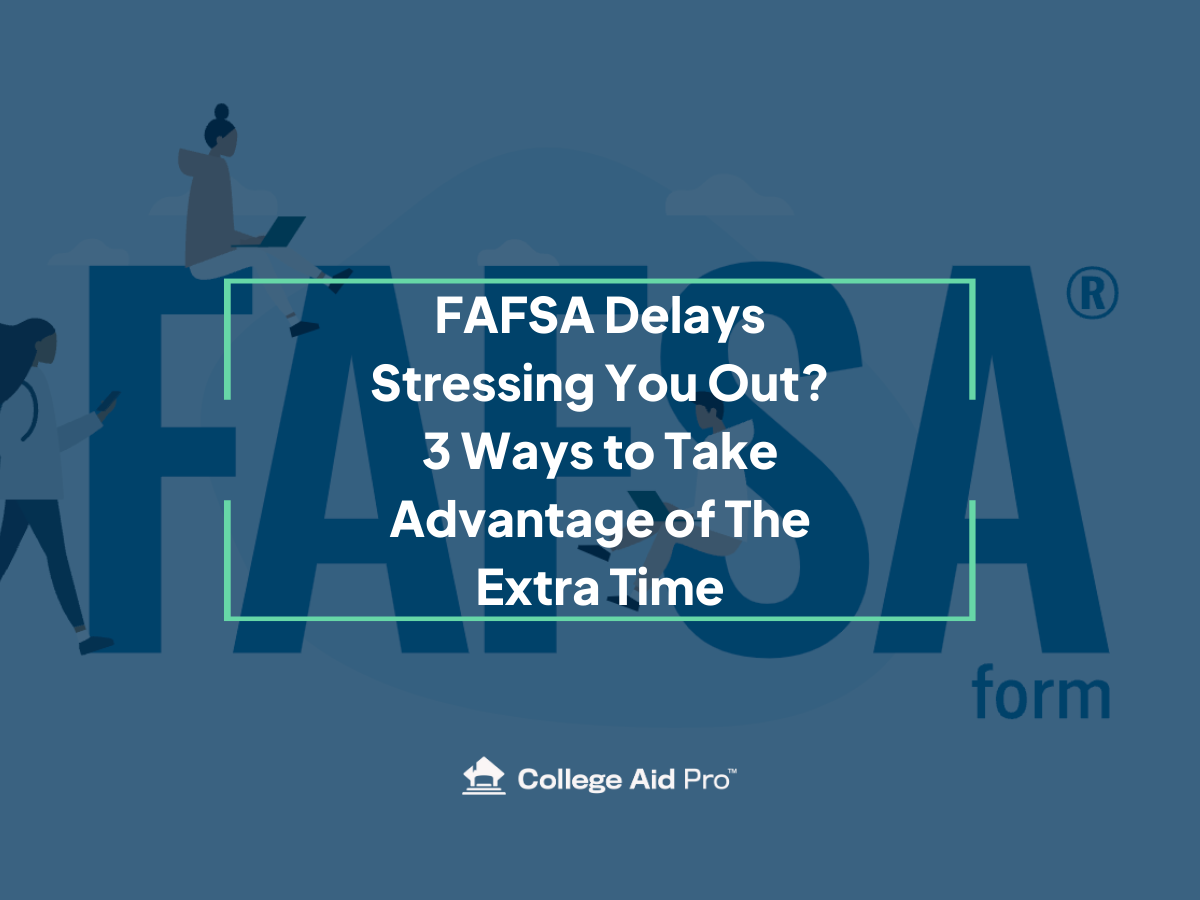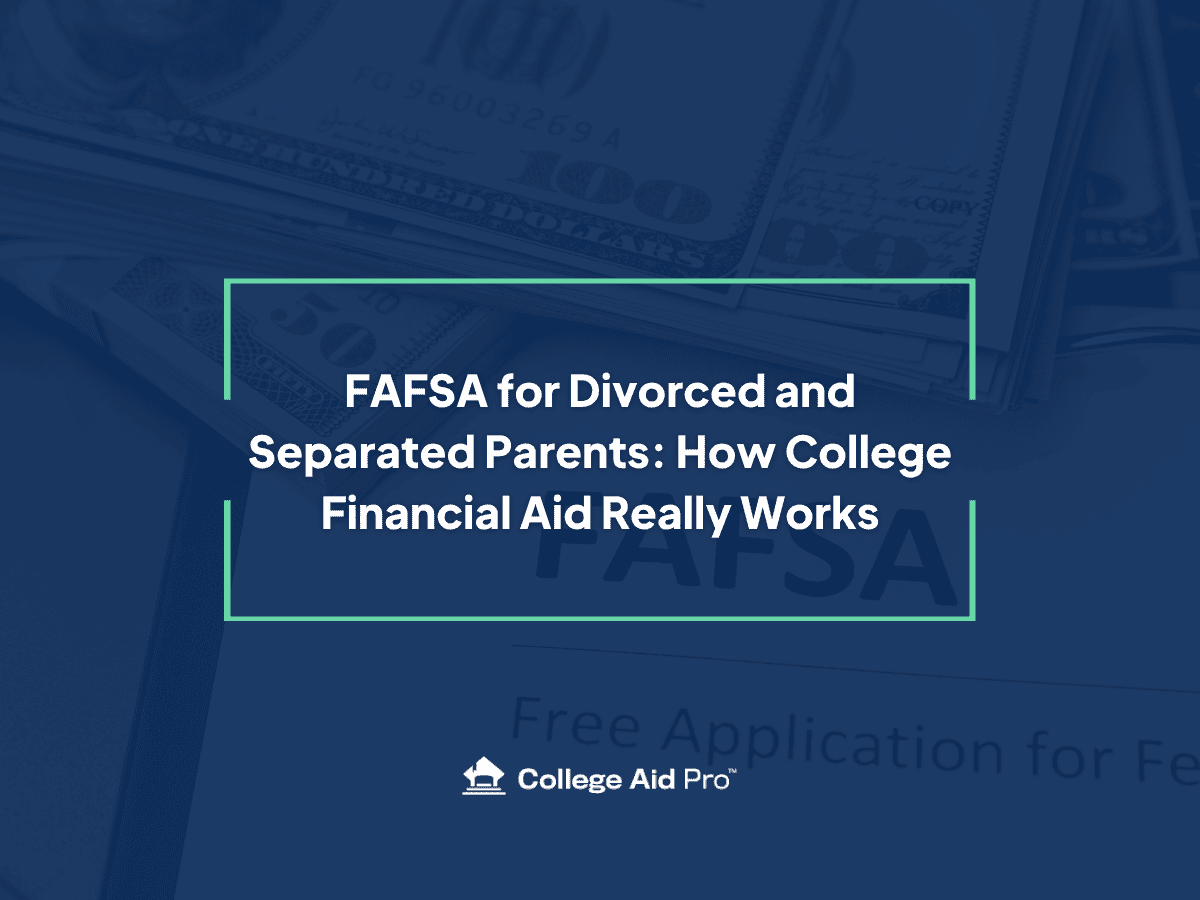How to Leverage the FAFSA Delays
Applying for student financial aid can be both overwhelming and crucial for students and their families. Once you figure out the process, fill out your forms, and submit them, you should feel like you can check something off your college to-do list.
However, with the late rollout of the new FAFSA form, glitches, and even more delays, this year it’s all very different. In this blog, we will explore how you can leverage the processing delays of the Free Application for Federal Student Aid (FAFSA) to maximize opportunities and make the most of the extra time.
Understanding FAFSA Delays
The FAFSA usually opens on October 1 of every year. This year however, the FAFSA didn’t open until December 31st. Why? The Department of Education did a major overhaul of the FAFSA; not just the actual form, but also how federal aid is calculated and awarded to students. This was a result of the FAFSA Simplification Act passed by Congress a few years ago.
The main goal of the FAFSA overhaul was to make the form easier for families to fill out – especially lower income families and first generation college students. In addition, the Pell Grant eligibility rules were changed to increase the amount of grants and money awarded.
So why the delays STILL? There are lots of reasons, and lots of opinions, but if you look at this from a high level, objective perspective, the delays are a result of a work in progress. While the form went through testing at some level, it was not fully put to the test until thousands of families started using the website and submitting their FAFSA. The Department of Education, under the leadership of Education Secretary Miguel Cardona, is working to address these challenges and streamline the process.
The latest FAFSA delay came out a couple weeks ago when the Department of Education announced that colleges and state agencies would not receive processed FAFSA forms until the first half of March (a significant change to the end of January which was the original timeline.) This delay was needed so the Department of Education could update calculations that will protect a larger portion of family income from being considered available for college expenses because of our current inflation rates. It will actually result in families receiving more federal aid, but it does mean more waiting.
The Impact of FAFSA Delays on Students and Families
The biggest impact to students and families is that financial aid packages from colleges are delayed now too. College financial aid departments need student’s FAFSA results to calculate individualized financial aid letters. Schools use your SAI (student aid index) calculated through your FAFSA to award grants and additional need-based aid. If a school doesn’t know your student aid index, they can’t accurately determine if and how much need-based financial aid you are eligible to receive.
In a typical year, students begin receiving financial aid letters as early as February. This gives them enough time to compare offers, possibly appeal and receive more aid, and make a final college decision by May 1st – National College Decision Day.
This year, the timeline is off. Most colleges won’t get financial aid packages out to students until end of March or beginning of April at the earliest. That would only leave a couple of weeks for students and families to make a very important, and possibly very expensive decision!
How Colleges are Responding to FAFSA Delays
Most college financial aid offices at this point are trying their best to keep up with the ever-changing 2024-25 FAFSA landscape. These offices have been bracing for impact for almost a year now and have undoubtedly come up with multiple plans to combat the FAFSA delay. Colleges expect to receive student FAFSA information sometime in the beginning of March.
How Colleges are Assisting Students During These Delays
Many colleges, including both the University of California and the California State University systems have already pushed back enrollment deadlines to later in May or June 1st. While other schools have suspended their commitment deadlines for right now.
Some schools are extending application deadlines as well. They are either pushing their regular decision application date, or moving to rolling admissions until further notice.
Institutions really do want to make this as easy as possible for students and their families. They are well aware of the additional stress and pressure this puts on such a large decision. At the same time, colleges don’t want students, especially those from low-income and first-generation backgrounds to see this FAFSA delay as an obstacle or reason to not commit to going to college.
According to the National College Attainment Network, a nonprofit whose mission is to close equity gaps in postsecondary success for students from all backgrounds, only 20% of the high school class of 2024 has submitted a FAFSA. This is a 49% decrease in national submissions from last year. While it’s not clear if the lower numbers are a result of the FAFSA delay or other things, this is NOT what colleges want to see.
The Department of Education also announced last week an effort to help colleges as a result of the FAFSA delay. They are allocating $50 million in federal funding for non-profit groups that specialize in financial aid support to provide additional support and technical assistance to under-resourced colleges with a special focus on minority-serving institutions.
Utilizing the Extra Time Effectively
While the FAFSA delays are frustrating, they also present an opportunity for students to make the most of the extra time. Instead of dwelling on the delays, use this extra time to your advantage! Only focus on what you can control at this point, and look at what you can do now.
Figure out What You’re Willing to Pay
This is the perfect time to get really dialed in on your projected net costs at the colleges on your lists. Look at your family’s budget for college and the cost of attendance at the colleges you applied to (without factoring in discounts and financial aid). Decide what bottom line price you would say yes to for each school. Draw a line in the sand NOW, so when those financial aid packages come in, you can sort them into colleges to consider and colleges that aren’t affordable.
If you aren’t exactly sure how to do this, you should check out our MyCAP software platform. With the free version, you can add 3 schools to your account, find out exact costs, projected merit scholarships and financial aid calculated based on your profile, and once you get your financial aid letters, you can upload them into your account and we’ll translate the data to see if you got the best deal, or if you should consider appealing for additional money.
Maximize Private Scholarships
Applying to private scholarships is another way to pay less for college. Research and apply strategically though. Focus on scholarships that align with your academic achievements, extracurricular involvement, and personal background. Explore local community organizations, businesses first. They may be smaller amounts, but there are historically less applicants that apply. Check with your high school counselor’s office to see if they have a database or place you can check on a regular basis. Many schools post local scholarships on their school website.
Appeal Financial Aid Awards for More Grants & Scholarships
While this is something that happens AFTER your receive your financial aid letter, now is a great time to get up to speed and educated on what an appeal is, how you appeal for more money and what kind, who appeals, and why you would do it. Appeal letters are typically based on asking for money need-based aid because their has been a change to your family circumstances, asking for more merit money based on what other schools offered you.
Dealing with Uncertainty during FAFSA Delays
Staying Informed and Prepared
It’s crucial for families and students to stay informed and aware right now. You can always check out our blogs and website for up to date information, or follow us on Instagram, or join our Facebook group. It’s also important to view the FAFSA delays as an opportunity, and explore strategies for effective private scholarship hunting and financial aid appeal opportunities.
Keep communication open and engaged with financial aid offices and admission offices at the colleges you’ve applied to. Attend admitted student day and invest time in getting to know the schools that are likely to be affordable no matter what additional financial aid your student gets.
No one likes a moving goalpost, and that’s exactly what these FAFSA delays and changes continue to feel like. We can’t change it now, but we can choose how we react. Take advantage of this extra time- you may be pleasantly surprised how this delay really isn’t the worst thing after all.



